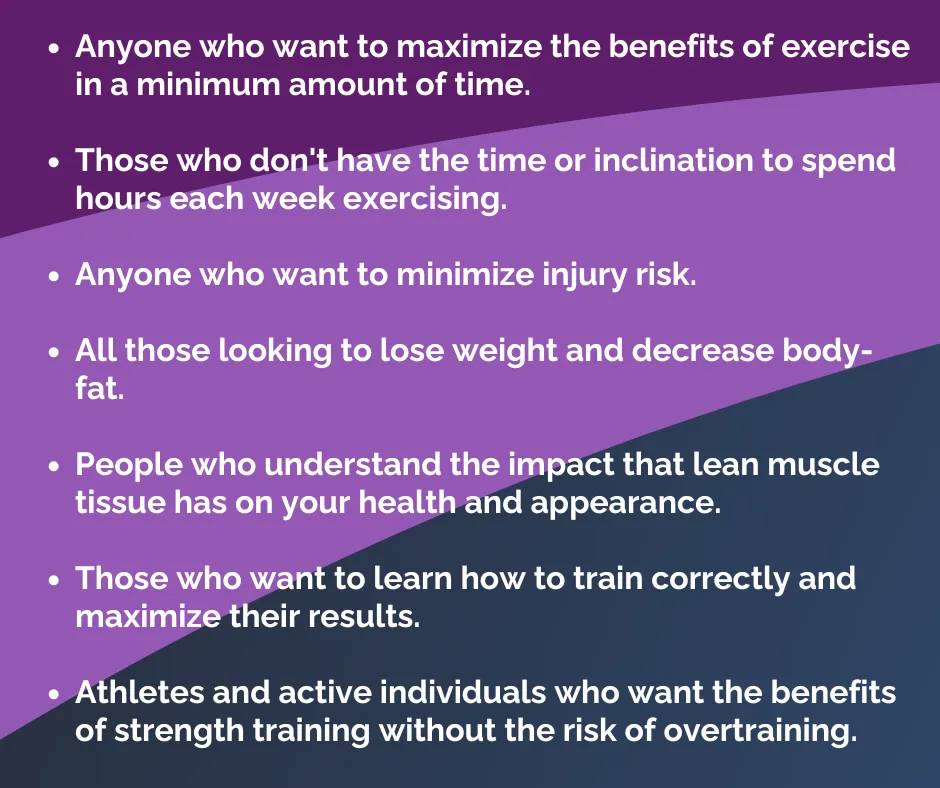STRENGTH Training
High Intensity
Strength Training
Brief, Hard & Infrequent
High Intensity Training or HIT is a smarter, safer way to stimulate muscle in a minimum amount of time to achieve maximum results.
What Is HIT?

Who Is HIT For?

Who Is HIT
Not For?

Fundamental Principles
of
High Intensity
Strength Training

What IS HIT?
HIT or High Intensity Training, coined by Ellington Darden, PhD back in the 1970’s, refers to high effort strength training. While effort is central to HIT, this style of training goes way beyond just intensity. Here are some of the primary governing principles of HIT:
Intensity
In this case intensity refers to the effort, not the weight used. In other words, it describes how hard you're working relative to your maximum ability. If you could do 10 reps maximum and you did 8 then you worked at 80% intensity.
It is generally recommended in HIT to train to Momentary Muscular Failure or 100% effort (in perfect form).
Progression
While not exclusively associated with high intensity training, HIT lays out a simple and systematic way to progress. HIT progression is typically based upon the performance of your most recent workout(s). Once you reach certain repetition/time under tension marker with a weight (i.e. 12 repetitions or 90 seconds TUT), you would raise that weight by 2-5% the next time you perform that exercise.
Form
Some lip service had been given to exercise form prior to the advent of HIT. However, HIT/Nautilus training was the first to start defining proper form for every exercise. Form is critical not only for safety but the effectiveness of an exercise. I would consider this the most important principle of all. Without proper form you compromise and confound everything else.
Duration
The time you spent working out is also a critical piece of the HIT/Nautilus protocol. As you work out harder, by necessity, you need shorten your workout duration.
“The secret, if there is one, is high intensity. And when you actually train with high-intensity, you don’t need a lot of volume.”
-Arthur Jones (Inventor of Nautilus)
Frequency
As with duration, the more skilled you get at working hard, the less frequently you need to workout. In order to recover from the exhaustive effects of exercise, you need to allow the body to rest. One of the biggest mistakes seasoned trainees make is working out too often.
Sequence
The sequence of exercises plays a critical role in programming. In general your workouts should always start with the largest muscles and finish with the smallest muscles. While there are exceptions to this rule, understand that ALL exercises will have an impact on the exercises that come after it. You should program your priorities toward the front of your workouts.
Less is More
In popular culture there tends to be a more is better attitude toward exercise. Conversely, in HIT we believe that the minimum amount of exercise necessary to produce the optimal result is what you should be aiming for. Any exercise beyond that point becomes counter productive.
Exercise is a stimulus to which the body must first recover from (i.e. replenish the resources used during exercise) before it can even consider positive adaptations. If you do too much and don't allow for recovery, you most certainly won't see the results you're looking for.
In summary, the primary governing principle of HIT are to keep your workouts:
Intense
Brief
&
Infrequent
While I have experimented with a variety of training protocols over my 30+ years in the fitness industry, I can confidently say that HIT is the best form of training for almost everyone I have ever worked with.

10
Science Backed
Reasons to
Strength Train
There are a multitude of science-based reasons you should strength train. Here are just a few:
Skeletal muscle quality and function decline with age and this is known as sarcopenia. Studies have shown that skeletal muscle mass will decrease at a rate of 1–2% per year after the age of 50, and skeletal muscle strength will reduce by 1.5% at age 50–60, even leading to sarcopenia. This can have dire consequences on our ability to function as we get older. Sarcopenic individuals are highly susceptible to falls and disability, and there is a turning point toward end-stage functional decline. Sadly, in large part, this can be prevented. Current studies have found that resistance training can alleviate age-related skeletal muscle degeneration and improve muscle strength, while also regulating blood glucose, and controlling blood pressure in the elderly.
Strength training should be an integral part of everyone's weekly routine. You will achieve tremendous benefits in a minimum amount of time (as little as 30 minutes weekly). It is the Fountain of Youth!